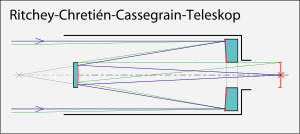Ritchey-Chrétien-Cassegrain telescope
The Ritchey-Chrétien-Cassegrain telescope , also known as the RC telescope , is a further development of the Cassegrain telescope in which the two mirrors are hyperbolically shaped. In this way, a coma-free image is achieved without a corrector such as a Schmidt plate , meniscus or other lens . However, since the field of view is not level, a lens system is placed close to the focus when using large Ritchey-Chrétien-Cassegrain telescopes to solve this problem.
The Ritchey-Chrétien system was developed by George Willis Ritchey and Henri Chrétien in the early 20th century .
Well-known Ritchey-Chrétien telescopes are the Hubble Space Telescope and the Very Large Telescope (VLT) of the Paranal Observatory in Chile. Variants of this design are now offered by various providers of amateur telescopes.
Comparison with the classic Cassegrain system
The size of the usable image field is an important parameter for the performance of a telescope. It is therefore sensible to examine the image field diameter from which the imaging errors exceed a value of 1 "to 2". This limit was chosen because an average seeing can resolve 2 ".
A Cassegrain telescope and a Ritchey-Chrétien-Cassegrain telescope with the same technical data are compared below:
- Opening diameter: 500 mm
- Focal length of the primary mirror: 1500 mm
- Focal length of the entire system: 4000 mm
The radius of the field curvature is over 500 mm in both systems.
Usable field diameter:
| Cassegrain telescope | Rc telescope | |
|---|---|---|
| with coma error ≤ 1 " | 0.095 ° | - |
| with astigmatism ≤ 1 " | 0.33 ° | 0.31 ° |
| with coma error ≤ 2 " | 0.19 ° | - |
| with astigmatism ≤ 2 " | 0.47 ° | 0.44 ° |
As the table shows, the size of the field of view of the Cassegrain telescope is limited by the coma error, whereas the RC telescope is only limited by astigmatism. With a maximum image error of 1 ", the RC telescope has a usable field of view that is around 3.3 times larger than the classic Cassegrain, and with a maximum image error of 2" the usable field of view of the RC telescope is still 2.3 times as big as the Cassegrain.
Due to the absence of coma, the RC telescope can be built with larger aperture ratios in a particularly compact design.
A disadvantage of the RC telescope compared to the Cassegrain is the need for corrector lenses if you want to work with the primary focus with the secondary mirror removed . The parabolic mirror of the Cassegrain then shows a perfect image on the optical axis, while the RC hyperbola images very poorly.
Design features of the Ritchey-Chrétien-Cassegrain telescope
As with all Cassegrain telescopes, the radii of curvature of the two mirror surfaces on the optical axis are described by the following two equations:
In it are:
- R 1 and R 2 amounts of the radii of curvature of the primary and secondary mirrors
- F effective focal length of the entire system
- B Distance from the secondary mirror to the focal point
- D Distance between the two mirrors
Note: In the literature, these radii are often given as negative numbers. This formally expresses that the light on its way through the instrument first passes the center points of the radii of curvature and then hits the surfaces.
Because of the two difficult to test hyperbolic mirror surfaces, the manufacture of small Ritchey-Chrétien-Cassegrain telescopes hardly makes sense. Grinding the mirrors is generally beyond the ability of an amateur astronomer. The adjustment of the two mirrors must be done with high accuracy. A very stiff telescope tube is therefore required.
Large Ritchey-Chrétien-Cassegrain telescopes
- The two 10 m telescopes of the Keck Observatory in Hawaii
- the four 8.2 m telescopes of the Paranal Observatory in Chile
- the 4 m Mayall telescope and the 3.5 m WIYN telescope of the Kitt Peak National Observatory
- the Hubble space telescope with 2.4 m primary mirror diameter
Individual evidence
- ↑ Stefan Deiters: Keck Telescope: Fascinating Images of Neptune. In: astronews.com. October 26, 2000, accessed November 25, 2019 .
- ↑ Ute Kehse: Artificial star allows the Keck telescope to see more clearly - Wissenschaft.de. In: Wissenschaft.de. October 13, 2003, accessed November 25, 2019 .
literature
- Rolf Riekher: Telescopes and their masters. 2nd, heavily edited edition. Verlag Technik GmbH, Berlin 1990, ISBN 3-341-00791-1 , pp. 317-318.
- Harold J. Abrahams: The Ritchey-Chrétien Aplanatic Telescope: Letters from George Willis Ritchey to Elihu Thomson. In: Proceedings of the American Philosophical Society held at Philadelphia for Promoting Useful Knowledge. Vol. 16, No. 6, December 1972, ISSN 0003-049X , pp. 486-501.
Web links
- The Hubble Program - Technology. NASA: Hubble Space Telescope Optics. In: asd.gsfc.nasa.gov. (English).
- HARPOINT OBSERVATORY (AUSTRIA). In: harpoint-observatory.com.
- Top class RC telescopes. Ritchey-Chretien systems from Alluna Optics. In: alluna-optics.de.


